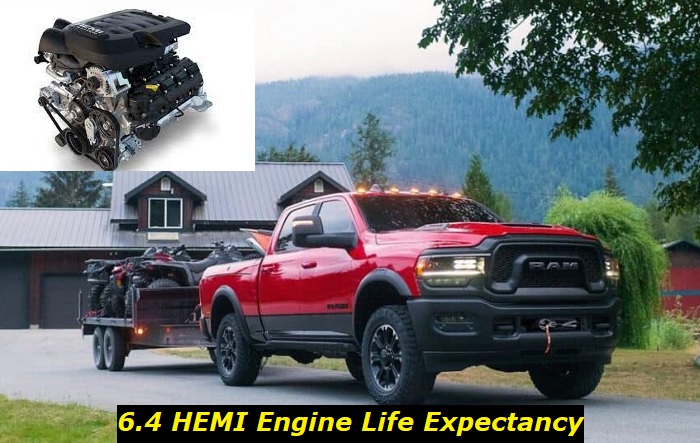In 2005, Chrysler showed the powerful and almost bulletproof engine called the 6.4 HEMI. This is a 6.4-liter or 392-cubic-inch engine that was aimed to be installed in performance versions of Chrysler cars and also in large and heavy SUVs. The engine is one of the most legendary units ever made by Chrysler and even now a lot of people are looking to buy this wonderful unit for engine swaps or upgrades.
Today, we'll tell you how long the 6.4 HEMI engine can live and at what mileage it will start showing its first problems. Also, we'll tell you about common issues with this engine. This will help you understand if you should still buy a certain engine when it is a high-mileage unit or if you should better stay away from it due to many potential problems.

Key features and my opinion about the engine
- Production years:2005-2024
- Average lifespan of 6.4 Hemi:230,000-270,000 miles
- Fuel supply type:port injection
- Power range:470-525 hp
- Fuel efficiency:awful
- Engine block material:cast iron
- Engine reliability score:high
- The most common problems:hydraulic lifters will fail with wrong oil viscosity, EGR problems, exhaust manifold problems, Hemi ticking noise issues.
What should you know about the 6.4 HEMI engine?
This is not the first (and most likely not the last) article about the HEMI engine, so we've already told you a bit about this technology. But the 6.4 HEMI is one of the most prominent units in the family and we need to focus on it now.
The engine came out in 2005 with a factory-rated output of 525 horsepower and a lot of mechanics immediately imagined how much power this wonderful block can hold if upgraded. With 510 lb-ft of torque, it would perfectly fit any Dodge truck, but instead, the company installed it in all SRT models of Chrysler 300, Challenger, Charger, Durango, Grand Cherokee, as well as in Grand Wagoneer and limited versions of the Wrangler.
Also, there were versions for trucks and chassis.
By the way, even now you can buy this engine new as a crate engine under the name 392 HEMI.
There are several modifications to this engine and we'll be talking mainly about the modification codenamed ESG. But everything we are telling you today is true for all 6.4L HEMI engines.
Here are the key takeaways about the engine:
- this is the V8 engine with the cast-iron block and aluminum heads that can develop 470 to 525 horsepower and up to 510 lb-ft of toque without upgrades;
- the engine is popular thanks to the opportunities for upgrades and it can get over 1000 horsepower without significant lifespan losses;
- 2 valves per cylinder may seem like not a lot but this engine is not only about performance but also about longevity;
- the timing system is driven by chain, the valve system has variable cylinder management and VCT, and also it's a naturally-aspirate engine with no turbochargers;
- the engine is pretty heavy, its weight is over 500 pounds, so fitting it into smaller vehicles may be a hard challenge;
- one of the key features is the hemispherical cylinder head that gave the name to the entire family of HEMI engines, this head ensures more efficient combustion.
The engine is pretty old in terms of the technologies used in it. It's heavy and not really fuel-efficient but it's durable thanks to all those bulletproof solutions that the manufacturer uses when making this unit. We understand that Chrysler could have made the 6.4 HEMI much more technological and powerful but they would risk its durability and they don't want to.
The 6.4L V8 engine is still sold in some models under Chrysler brands and we know some people who hunt those engines. If you like the feeling that the V8 engine gives you, hurry up! The 6.4 HEMI certainly lives its last years on the production lines. The engine is hard to fit into certain ecology limitations, so it's going to be discontinued very soon.
How many miles will the 6.4 HEMI last?
Sorry, it took us so long to come closer to the longevity topic but we just needed to tell you more about the nature of this engine to prove everything we are telling you now is true. So, the 6.4 HEMI is a super-reliable engine that can go many years and not even show a minor problem if maintained well.
In our opinion, the average lifespan of the 6.4L HEMI engine should be considered about 280,000 miles. While some really well-maintained units will even last as long as 400,000 miles without the need to repair the engine after serious breakdowns. You will still have to deal with unpleasant minor faults and issues, but those are not that hard to deal with.
We've also seen 6.4L Chrysler engines overhauled earlier than they managed to hit 150,000 miles. This is most likely connected to maintenance and driving style. These engines are used in SRT and SRT8 models that are made for performance and aggressive driving. So, sometimes, HEMI engines don't get a calm life and need to be repaired sooner than you may expect.
To better understand the durability of this engine, you should also know about its common problems and the average mileage points when these problems appear.
Common problems that may shorten the lifespan of the 6.4 HEMI
Unfortunately, the 6.4L Chrysler engine is not eternal and it's going to get on your nerves a bit with some minor problems. After the mileage hits the 200,000-mile mark, the engine may show more serious issues that need more money and expertise to deal with. Although these engines are commonly reliable and live long, they can throw surprises now and then and you should be ready for them.
So, let's see what you should expect.
1. Monstrous gas mileage
While a normally operating 6.4 Hemi should get 14 to 18 MPG depending on the driving style and road conditions, sometimes the mileage can go much lower. We've seen Dodge owners saying that their HEMI engines deliver 8 MPG and they can't find the reason why.
In most cases, you will have to use a code scanner to see if some sensor is malfunctioning. Also, the cylinder management system may be a hidden reason for bad gas mileage. Another possible reason is the wrong oil type. The wrong type of oil will stop hydraulic lifters from working well and the valves will open and close randomly.
2. Cylinders turning on and off
The cylinder management system is not something Chrysler should be proud of in these HEMI engines. It can turn off 4 cylinders when you drive on the highway and just need the power to maintain a certain speed. But after the engine hits that 200,000-mile mark, the cylinder management system may malfunction and your cylinders may be deactivated forever.
Or they also can activate and deactivate randomly giving you a different amount of power each time you start your engine. Repairs are pretty complicated and expensive.
3. EGR valve
Many thanks to Chrysler for the EGR valve in this gasoline engine. Yes, they need to fit the unit into some ecology standards, but the EGR will just take your brain out of your head and play with it. In high-mileage cars, this unit will be one of the most common reasons why your vehicle spends days and nights in the dealership.
EGR valve gets stuck after it clogs which inevitably happens at some point. You get all kinds of error lights and messages and also your engine loses power.
4. Exhaust manifold issues
We also know about quite a lot of complaints from owners about the exhaust manifold. When the engine is overheated (which is not a rare thing for a performance V8 machine), the exhaust manifold can bend a little, and then the fasteners will go bad. This will lead to exhaust gases escaping the system much earlier than they can go through the cat converter and oxygen sensors. This will cause check engine lights, limp mode, lack of power, and all those kinds of problems.
5. HEMI ticking issues
There are several reasons why your 6.4L HEMI may be ticking, so there is even a special term for this - HEMI ticking. We won't go too deep into the technical side of the question but we should say these engines are pretty loud and they create all kinds of different noises when they work. Sometimes, the noises are just natural but the ticking sound should warn you about some problems with the head.
Reasons for the premature death of 6.4 HEMI
So, in most cases, 6.4L HEMI engines die prematurely because of these factors:
- severe overheating;
- bad and inappropriate oil in the engine;
- no attention to ticking noise;
- ignoring signs of major issues;
- too aggressive driving;
- overrevving for a long period of time;
- no proper regular maintenance;
- long periods of inactivity.
Please keep in mind that this engine is bulletproof in those cases only when it's used and maintained well. And although this is a really tough and cool unit, it still needs a lot of attention to go more miles and years and to prevent it from failing.
About the authors
The CarAraC research team is composed of seasoned auto mechanics and automotive industry professionals, including individuals with advanced degrees and certifications in their field. Our team members boast prestigious credentials, reflecting their extensive knowledge and skills. These qualifications include: IMI: Institute of the Motor Industry, ASE-Certified Master Automobile Technicians; Coventry University, Graduate of MA in Automotive Journalism; Politecnico di Torino, Italy, MS Automotive Engineering; Ss. Cyril and Methodius University in Skopje, Mechanical University in Skopje; TOC Automotive College; DHA Suffa University, Department of Mechanical Engineering






Add comment